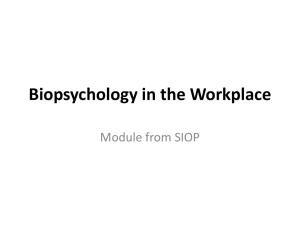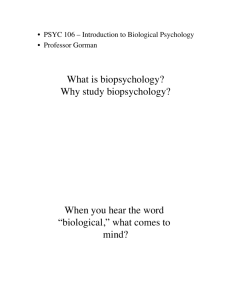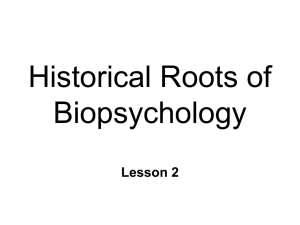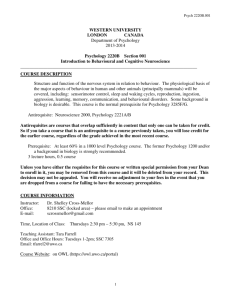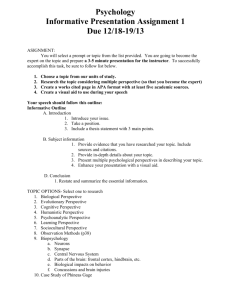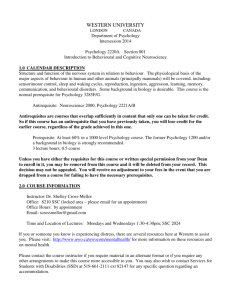Psyc 215-001 john conklin
advertisement
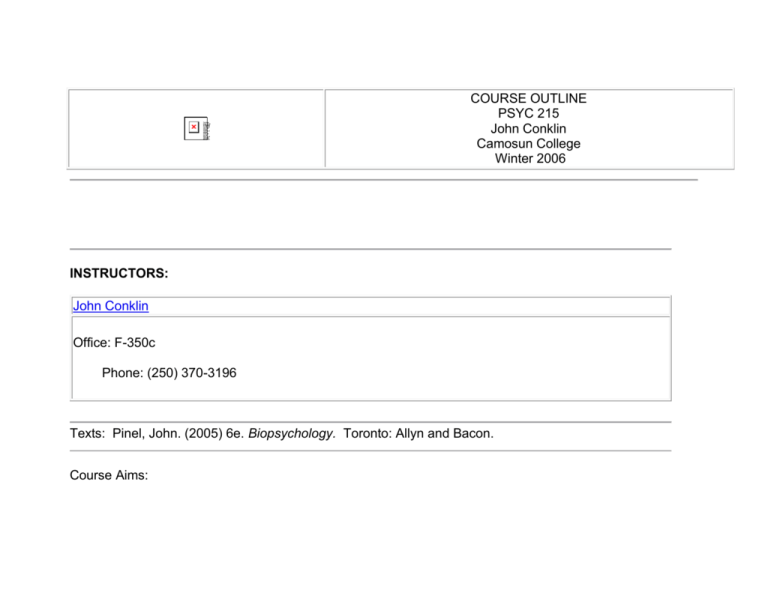
COURSE OUTLINE PSYC 215 John Conklin Camosun College Winter 2006 INSTRUCTORS: John Conklin Office: F-350c Phone: (250) 370-3196 Texts: Pinel, John. (2005) 6e. Biopsychology. Toronto: Allyn and Bacon. Course Aims: This course provides an overview of the field of biopsychology including the basic structures and functions of the central nervous system (CNS), the structure and functions of neurons, methods of research and treatment used in biopsychology, and the correlations between the CNS and behaviour. This syllabus/course outline emphasizes three themes. The theme of methodology encourages the student to understand and evaluate the methods used in the development of the field of biopsychology. The theme of explanatory models or theories encourages the student to consider what theories are current in the field of biopsychology, their history and possible future development. The theme of ethics encourages the student to look at the impact of psychology on the participants of psychology studies, and the impact of biopsychology on everyday life. Core Topics: The major topic areas that we will cover in this course are derived from the Pinel textbook Biopsychology and include a definition of the field of biopsychology and a comparison with similar fields. a look a the foundations of the field of biopsychology including the field of evolutionary biopsychology, a consideration of the nature-nurture debate in psychology and its resolution in contemporary biopsychological theory, the basic anatomy of the nervous system, neural conduction and synaptic transmission, and an overview of research methods used in biopsychology. a look at the biopsychology of sensation and perception and the sensorimotor system. a consideration of the central feature brain plasticity plays in our current thinking about the development of the central nervous system, recovery from brain damage, and learning and memory. a look at the concept of motivation from a biopsychological perspective, including hormones and sex, sleep and circadian rhythms, and current models of the cause of drug addiction with reference to the brain's reward systems. and finally, a brief look at the disorders of cognition and emotion including the results of split brain operations, emotions, stress and health, and the biopsychology of disorders such as schizophrenia, Parkinson's, Alzheimer's, autism, schizophrenia, depression and various anxiety disorders. Each topic area will include basic information provided by the textbook, lecture and CD Rom; additional reading, often experimental write-ups or review articles, and laboratory demonstrations and experiments. The materials have been chosen to allow students to learn and demonstrate: knowledge and understanding of approaches to the solution of problems via the scientific method. an ability to analyze and to evaluate some of the cultural, social, and ethical implications of biopsychology; an ability to apply biopsychological concepts to practical problems and to everyday life. The aims of this course are: To provide an introduction to concepts, theories (explanatory models), research findings and applications in the field of biopsychology. To create an understanding of the range and limitations of theory and practice in biopsychology, to look at the past evolution of theory and consider future developments. To encourage students to explore and understand the relationship between the field of biopsychology and everyday life. To develop skills of analysis, interpretation, application and evaluation. To promote an appreciation and understanding of the the individual, his/her development and the interaction of genetic, biological, learning and social forces in human behaviour. To develop an understanding of ethical issues in biopsychology including the moral and ethical implications of various research methods and procedures. To explore and understand the relationship between biopsychological findings and theory and social, economic, sociological, geographic and political issues. To encourage the development of the skill of communicating the ideas, concepts and controversial issues in the field of psychology in general, biopsychology in particular. Assessment Objectives An assessment objective is an intended area of competence within the subject. There are two main assessment objectives for this course. Knowledge and Understanding Knowledge of biopsychology is an essential outcome of the study of the field and includes knowing the basic facts, terminology and concepts of biopsychology. Understanding is the skill of interpreting what the knowledge means. For example, a description of a study such as Tryon's (1934) "maze-bright" and "maze-dull" rats that includes details of his experimental procedures and results represents knowledge. On the other hand, the meaning of his results, the results of future experiments based on his results (his original breeds of rats are still being used) and the re-interpretation of his results in the light of contemporary theories or explanatory models in biopsychology represents understanding. Successful students should be able to: demonstrate knowledge and understanding to contemporary biopsychological theories, terminology, studies and methods in the areas of ; evolution and genetics of behaviour anatomy of the nervous system neural conduction and synaptic transmission research methods in biopsychology the biopsychology of sensation and perception with emphasis on vision, conscious awareness and attention. the sensorimotor system brain plasticity in brain damage, neural development, learning and memory the biopsychology of motivation, esp. sex, sleep and the role of the brain's reward system in drug addiction disorders of cognition and emotion. express knowledge and understanding in a clear and effective manner Analysis, Evaluation and Application Analysis is the ability to express information and ideas in a clear and accurate style. It is also the ability to identify key points in a study and see their relationship to other studies and theories, and also the ability to make valid generalizations. In the example of Tryon (1934) one of the key points is that selective breeding, forced genetic divergence can affect behaviour in a significant way and that selective breeding based on one behaviour trait usually brings a host of other behavioural traits along with it. Generalizations can be made about the role of genes in the cause of behaviour and the interaction of genes and experience in the etiology of specific behavioural traits. Evaluation skills can be identified in terms of the ability to point out methodological errors and consider their effect on the data, the ability to consider the quality of the data, the ability to consider the ethics of the study, and the ability to consider the scientific value of the outcome of the study. In the example of Tryon (1934) the student needs to consider subsequent research by Searle (1949) and Cooper and Zubek (1958) which expands the original theory and incorporates other traits and other, more complex, environmental genetic interactions. Application skills, in the context of this course, are skills involved in the application of a finding or theory to a new situation of everyday situation. The skill of application can also be shown by the ability to consider a new research finding and apply it to existing biopsychological theory. In the Tryon example application can be demonstrated by relating this study to contemporary concerns over the effects of childhood deprivation in countries with considerable poverty, such as the United States, or in debate about the potential of genetic engineering for selective intelligence. Successful students should be able to: analyze and evaluate biopsychological theories, terminology, concepts, studies and methods in the areas listed above. apply biopsychological theories, concepts and studies to practical situations, everyday life and to the experience of the student. I. Course Description For the calendar description of this course click here. Psychology 215, Biological Psychology, is second year course designed for university transfer students who intend to continue their education in psychology, sciences or related fields. It could also prove interesting and useful to anyone with an interest in human behavior and its relationship to the central nervous system. Along the way scientific method, genetics, neuroanatomy, biochemistry, development, perception, movement, sexual behavior, brain damage, mental disorders, methods of assessment, etc. will be discussed. II. Course Requirements: Psychology 215 is a second year course so I will make certain assumptions about your background in psychology and your intellectual and research skills. I will assume that you have a general grounding in psychology including methods of research, the basics of schools or approaches to psychology, and an overview of the content areas of psychology such as sensation, perception, learning, abnormal, developmental, social, etc. If I mention the difference between correlational research and experimental research or the relationships between sensation and perception I will assume that no explanation is needed. I also assume that you have written a research paper, are somewhat skilled at finding primary source material in a library and understand the rules of citing sources in research papers. You may not be familiar with the intricacies of APA (American Psychological Association) style, but I assume that you are familiar with some style and can adapt to APA style. For a quick overview of APA paper style have a look at the APA Style Guide Summary produced by the Camosun College Psychology Department in this WebCT table of contents or try APA Style Resources. I assume that you know the rules for citing sources in research papers. If you are unclear about this please ask before the paper is due. III. Course Organization This course involves lectures, seminars, written assignments done on your own, and tests using the internet facilities of WebCT to provide information about the course and enhanced learning opportunities. I will offer you the opportunity to use computers extensively in this course. I will make computer accounts available for you and give you basic instructions on using e-mail, word processing and computer mediated research. Both the computing services department and the library offer workshops on the use of computers and research skills. For some basic information on computer ethics have a look at the Camosun Computer Users Ethic Policy IV. Marking ASSIGNMENTS Weekly Labs & practice tests 20% Article Review 10% Mid-Term Exam 20% Final Exam 25% Research Paper 25% MARKING SYSTEM A+ 94.5%-100% B- 69.5%-74.5% A 89.5%-94.5% C+ 64.5%-69.5% A- 84.5%-89.5% C 59.5%-64.5% B+ 79.5%-84.5% D 49.5%-59.5% B 74.5%-79.5% F 0-49.5% ASSIGNMENTS In general all work and assignments must be handed in on the due date. If an emergency or serious problem comes up prior to the exam or due date you may apply for an extension. This must be done in person before, preferably well before, the date in question. I would prefer to receive work via WebCT email as an attachment. If you are using MS Word just send your .doc file. If you are using Works, or WordPerfect or an Apple word processor safe your file as a "Rich Text Format" file (.rtf) and send that as an attachment. Work occasionally goes missing at an institution so you are responsible for keeping a copy of all work handed in. One advantage of e-mailed assignments is that I have a permanent record of the file, when it was sent, etc. and I will have a copy of the marked paper that I return to you via email. All work must be handed to me in person or e-mailed. All written work must be in APA format. WEEKLY LABORATORY ASSIGNMENTS Each week there will be a laboratory assignment and a practice test. Each practice test is worth 1 of one percent which you will receive if you get 50% or better on the test. The weekly lab assignments are found in the assignments section of the course. Lab work will be done both outside of class and in lab time in a computer lab. Sometimes we will do the whole lab in the the lab hour, sometimes you will gather data outside of class and we will analyze the data and discuss the experiment or demonstration in the lab time. EXAMS There will be two exams during this course. The first, about half way through, will cover the material to that point. It will include multiple choice questions, diagrams, short answer and essay questions. A study guide in the form of "goals" is attached to each chapter study guide in WebCT. The second exam will be a comprehensive exam covering material from the whole year. Approximately 33% of the exam will be from before the midterm and 66% from after the midterm. All exams will be taken on computer in the Ewing computer labs. What a joy it is to have the computer mark the m/c questions and to mark keyboarded essays rather than 100 versions of handwriting! If you really can't use a keyboard let me know and we'll make arrangements for you to use the computer for the objective part of the test and then hand write the essays. Material for the exams will be drawn from the "Goals" which are attached to each chapter's lecture notes. ARTICLE REVIEW The basis of most research in psychology is in knowing the nature of what has come before. Most research is designed to test a theory (explanatory model) by devising an experiment or set of observations that would develop in a particular direction if the theory is correct. But a theory is never created wholly out of the present, it is based on the past, on previous thinking and experimentation. Most research reports begin with a review of previous literature. This assignment involves obtaining some previous literature, from a psychological journal, and summarizing it briefly. This involves reading something about a topic from primary sources. Search for primary sources in an index, usually "Psychological Abstracts", called PsycInfo in the library on-line research system. EbscoHost is also there and is a good source of full text on-line primary source journal articles. Obtain a copy of the article, read it, and summarizing it. For our purposes you need only summarize the theory or explanatory model being investigated and what their results say about that theory or model. If you obtained your article from the Internet your bibliography will contain the URL (Internet address) will appear in your reference section and I will be able to click on in it and read the article. This assignment should be about 250 words. Note: Make sure that your article has to do with the topic of this course: Biopsychology There is a model of a good review in the WebCT table of contents. Please read the Article Review Guidelines ! RESEARCH (REVIEW) PAPER A review paper is one that gathers the most recent relevant information about a topic, organizes it and presents a summary of findings from several recent sources. A typical topic would be the current state of theories or models of the cause of schizophrenia. A writer would find several "primary source" articles, organize their content and present a summary that basically answers the question: "what is the current state of the field with regard to models of the etiology of schizophrenia?" There may be several competing theories in which case the paper would be organized along the lines of a compare and contrast paper that draws conclusions. This paper should be a minimum of five pages or about 1250 (5 x 250) words exclusive of the title page, and reference list. It should include "several," around 10 sources is about average, almost all primary sources. Don't get hung up on the number of sources; you need sufficient empirical data to support your points. Textbooks, encyclopaedias, and the like are not appropriate sources for research papers and would be used only in rare circumstances. The reference list should contain only sources actually used for the paper, no filler please. See the research paper guidelines in the WebCT table of contents. Please read the Research Paper Guidelines ! Flexibility: The above is well organized and sensible, but it may not suite your learning style. If you would like to make some modifications in the way you take the course please come and discuss it with your instructor. For example, some people just hate multiple choice tests so we could arrange tests for you that are all essay, or we could arrange a course that it all papers, no tests at all. The only thing we would not feel comfortable arranging is an evaluation scheme that was all multiple choice tests, no writing, no integration of knowledge. This must be arranged and agreed to by both of us before the end of the second week of classes. LEARNING SUPPORT AND SERVICES FOR STUDENTS There are a variety of services available for students to assist them throughout their learning. This information is available in the College Calendar, Registrar’s Office or the College web site at http://www.camosun.bc.ca ACADEMIC CONDUCT POLICY There is an Academic Conduct Policy which includes plagiarism. It is the student’s responsibility to become familiar with the content of this policy. The policy is available in each School Administration Office, Registration, and on the College web site in the Policy Section. www.camosun.bc.ca/divisions/pres/policy/2-education/2-5.html Presumed Knowledge: Presumed Knowledge for Psychology 215 In order to get the most out of Psychology 215, An Introduction to Biopsychology the following are recommended: Knowledge A basic understanding of the various fields and activities of psychology. See for example the homepage of the American Psychological Association http://www.apa.org/ or the Canadian Psychological Association http://www.cpa.ca/ and the various divisions and activities listed there Some basic understanding the structure of the brain would be useful. The brain is constructed of neurons, various centres of the brain perform different functions, etc. Have a look at: http://faculty.washington.edu/chudler/introb.html I know it says “neuroscience for kids” but it is a good foundation in biopsychology. Some understanding of very basic chemistry would be very useful, ions, osmosis, etc. Again Chem4kids http://www.chem4kids.com/ has all the basic background that you should need. A bit more advance is the Chemistry Basics site: http://chem.neopages.com/tutorials/basc.shtml The whole field of biopsychology is based on the scientific method and its various research methods. For an introduction to the scientific method try here: http://teacher.nsrl.rochester.edu/phy_labs/AppendixE/AppendixE.html or http://home.xnet.com/~blatura/skep_1.html or http://koning.ecsu.ctstateu.edu/Plants_Human/scimeth.html I would be good to have some basic understanding of several basic human functions that have been investigated by psychology: for example: Memory: The San Francisco Exploratorium memory exhibit: http://www.exploratorium.edu/memory/ Perception: The Joy of Visual Perception http://www.yorku.ca/eye/noframes.htm Tutorials in Sensation and Perception http://psych.hanover.edu/Krantz/sen_tut.html Disorders, etc. This site has links to a variety of relevant topics including basic information of a number of mental disorders: http://cep.jmu.edu/psychology/neuro/ For a basic on-line review of psychology including videos click here: http://cybersisman.com/aepsychology1a/ For many links that preview topics taught in this course: http://www.univ.trieste.it/~brain/NeuroBiol/Neuroscienze%20per%20tutti/ehceduc.html [These prerequisites would usually be covered by taking Camosun Psychology 110 and one of 120, 130, 150, or 164.] Skills: The most important skill in any science course is being able to find current information about what is going on in the field from primary sources. This used to be called “library research” and now would be called Internet/library research I guess. Here is a tutorial that includes video from the Cornell library: http://www.library.cornell.edu/okuref/research/tutorial.html Here are some hints from the APA site: http://www.apa.org/science/lib.html And here are tips for using PsycInfo from their web site: http://www.apa.org/psycinfo/training/ Writing a Research Paper: Hopefully you will have written a research paper with some guidance in an English course. For review try here: A Guide for Writing Research Papers based on Styles Recommended by The American Psychological Association http://webster.commnet.edu/apa/apa_index.htm Writing a Research Paper Purdue Univ. http://owl.english.purdue.edu/workshops/hypertext/ResearchW/ Ten steps in writing a research paper http://library.ust.hk/serv/skills/libskill.html Dr. Gwen's Research Paper Information Page http://www.fccj.org/LearningResources/DrGwen/research.htm [These prerequisites would usually be met by taking an English course in which a research paper is written (Camosun English 150), or another course where such a paper is produced] Computer and Internet Skills Much that is helpful for this course is online. We don’t do anything that you can’t learn as we go, but it would be very helpful if you knew how to use a keyboard with 10 fingers (“type”); find information on the Internet, and create and send files using a word processor and email system. [These days many of these skills are picked up by having an Internet linked computer in the home, or taking a course such as Camosun Comp 156.] Attitudes: To get much out of a course like this you need to possess the basic attitudes of science. You need to open to new ideas, willing to subject your beliefs to testing, you need to see learning new stuff as just about as much fun as a person can have and you need to be willing to do all this publicly. See also: Values and attitudes in science: http://isis.csuhayward.edu/ALSS/soc/NAN/scivals.htm American Scientist site: http://www.americanscientist.org/ Copyright by John Conklin, Camosun College; Victoria, B.C. Canada: Last Updated:
